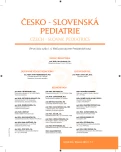Transient pseudohypoaldosteronism – „puzzle“ of pediatric nephrology and urology
Authors:
Z. Doležel 1; P. Jabandžiev 1; Z. Ráčilová 2; J. Štarha 1; D. Dostálková 1; P. Zerhau 3
Authors‘ workplace:
Pediatrická klinika LF MU a FN Brnopřednosta prof. MUDr. Z. Doležel, CSc.
1; Klinika dětské radiologie LF MU a FN Brnopřednosta doc. MUDr. J. Skotáková, CSc.
2; Klinika dětské chirurgie, ortopedie a traumatologie LF MU a FN Brnopřednosta prof. MUDr. L. Plánka, Ph. D.
3
Published in:
Čes-slov Pediat 2014; 69 (1): 3-11.
Category:
Original Papers
Overview
In childhood the majority of changes in serum electrolytes concerns dysbalance of sodium and potassium. Hyponatremia accompanied by hyperkalemia is usually associated with disorders of the adrenal glands, but may also occur in the course of kidney diseases or disorders of gastrointestinal tract. Pseudohypoaldosteronism is an example of salt-losing syndrome and is characterized by hyponatremia, hyperkalemia, metabolic acidosis, high serum aldosterone and high plasma renin. One type of this condition is transient pseudohypoaldosteronism type I. Its development occurs most frequently in neonates or infants in association with urinary tract infections and/or urinary tract anomalies.
We present a group of 14 children (6 girls, 8 boys, mean age 5.6 months) with transient pseudohypoaldosteronism type I, in 12 of them were cause of this type pseudohypoaldosteronism urinary tract anomalies accompanied by urinary infection, in 2 patients were cause acute pyelonephritis without obstructive uropathy. In all children the blood chemistry values were normalized after treatment of urinary infection, 4 patients with serious urinary tract anomalies were required urologic surgery. It is important that urinalysis and renal ultrasonography should be performed in any newborn or infant presenting with salt-wasting with hyperkalemia to exclude urinary tract anomalies or urinary infection as the cause of the dyselectrolytemias.
Key words:
transient pseudohypoaldosteronism, urinary tract infection, obstructive uropathy
Sources
1. Dolezel Z, Starha J, Novotna D, et al. Secondary pseudohypoaldosteronism in an infant with pyelonephritis. Bratisl Lek Listy 2004; 105 (12): 435–437.
2. Torun-Bayran M, Soylu A, Kasap-Demir B, et al. Secondary pseudohypoladosteronism caused by urinary tract infection associated with urinary tract anomalies: case reports. Turk J Pediatr 2012; 54 : 67–70.
3. Kostakis ID, Cholidou KG, Perrea D. Syndromes of impaired ion handling in the distal nephron: pseudohypoaldosteronism and familial hyperkalemic hypertension. Hormones 2012; 11 (1): 31–53.
4. Bogdanovic R, Stajic N, Putnik J, et al. Transient type 1 pseudo-hypoaldosteronism: report on a eight-patient series and literature review. Pediatr Nephrol 2009; 24 : 2167–2175.
5. Thies K-C, Boos K, Müller-Deile K, et al. Ventricular flutter in a neonate – severe electrolyte imbalance caused by urinary tract infection in the presence of urinary tract malformation. J Emerg Med 2000; 18 (1): 47–50.
6. Fahimi D, Mohajeri S, Hajizadeh N, et al. Comparison between fractional excretions of urea and sodium in children with acute kidney injury. Pediatr Nephrol 2009; 24 (12): 2409–2412.
7. Gotfried J, Wiesen J, Raina R, et al. Finding the cause of acute kidney injury: which index of fractional excretion is better? Cleve Clin J Med 2012; 79 (2): 121–126.
8. Belot A, Ranchin B, Fichtner C, et al. Pseudohypoaldosteronism, report on a 10-patient series. Nephrol Dial Transplant 2008; 23 (5): 1636–1641.
9. Alper SL. Familial renal tubular acidosis. J Nephrol 2010; 23 (S16): 57–76.
10. Devuyst O, Konrad M, Jeunemaitre X, et al. Tubular disorders of electrolyte regulation. In: Avner ED, Harmon WE, Niaudet P, Yoshikawa N (eds). Pediatric Nephrology. 6th ed, vol 1. Heidelberg, Berlin: Springer-Verlag, 2009 : 929–977.
11. Grym J, Goldemund K. Základy rehydratační léčby v pediatrii. Olomouc: Solen, 2013 : 1–270..
12. Nandagopal R, Vaidyanathan P, Kaplowitz P. Transient pseudohypoaldosteronism due to urinary tract infection in infancy: a report of 4 cases. Int J Pediatr Endocrinol 2009; Article ID 195728, 4 s.
13. Štíchová L, Pajerek J. Neprospívání a recidivující hyponatremie u kojence. Pediatr Pro Prax 2013; 14(1): 42-44.
14. Sopfe J, Simmons JH. Failure to thrive, hyponatremia, and hyperkalemia in a neonate. Pediatr Ann 2013; 42 (5): 74–79.
15. Riepe FG. Pseudohypoaldosteronism. Endocr Dev 2013; 24 : 86–95.
Labels
Neonatology Paediatrics General practitioner for children and adolescentsArticle was published in
Czech-Slovak Pediatrics

2014 Issue 1
- What Effect Can Be Expected from Limosilactobacillus reuteri in Mucositis and Peri-Implantitis?
- The Importance of Limosilactobacillus reuteri in Administration to Diabetics with Gingivitis
Most read in this issue
- Cryptorchidism – the need of early diagnostics and treatment
- Transient pseudohypoaldosteronism – „puzzle“ of pediatric nephrology and urology
- The care of prematurely born child: when to begin and end?
- Adipsic diabetes insipidus in a child with dysgenesis of corpus callosum
